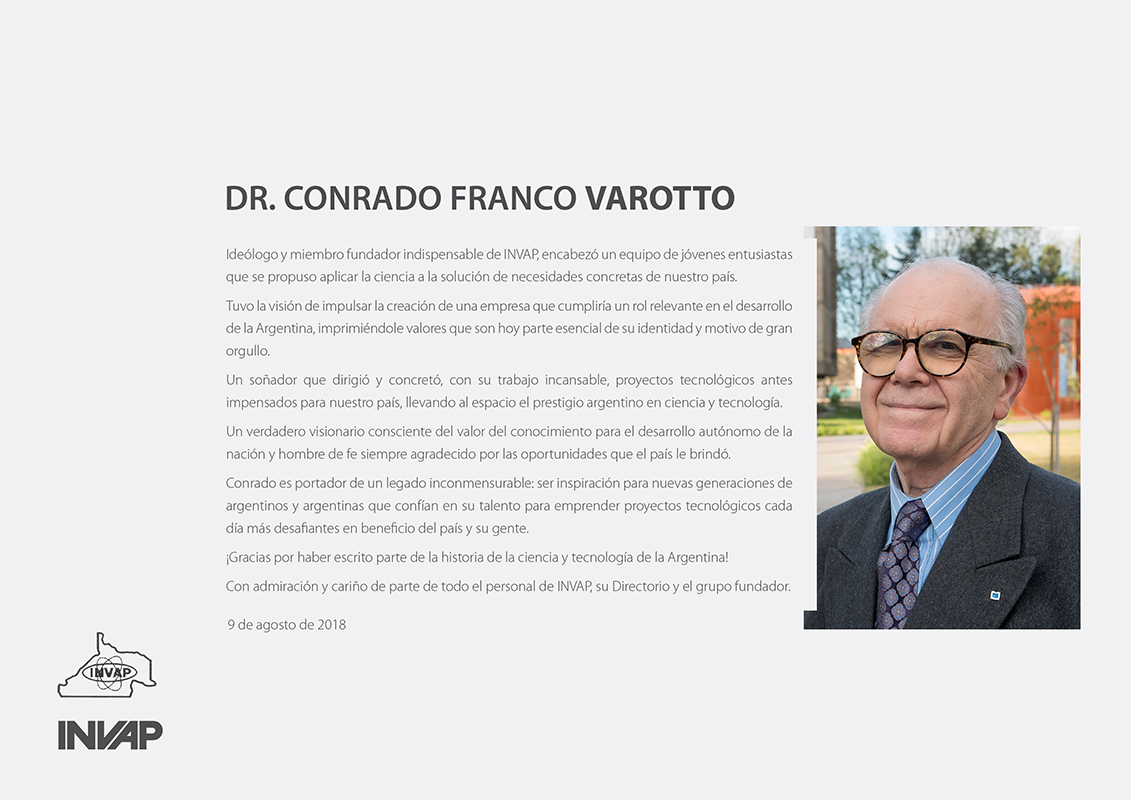2018
With the presence of the President of the Argentine Nation, Engineer Mauricio Macri, together with national and provincial authorities, the launch of the SAOCOM 1A satellite took place this morning, at the Casa Rosada Museum. The event –presided over by the Minister of Science, Technology and Productive Innovation, Dr. Lino Barañao; together with the Secretary of Planning and Policies, Engineer Jorge Aguado; and the Executive and Technical Director of the National Space Activities Commission (CONAE, in Spanish), Engineer Raúl Kulichevsky– also included a tribute to the former Executive and Technical Director of the CONAE, Dr. Conrado Varotto.
The homage to Dr. Varotto, founding member of INVAP, was also attended by the following authorities of the company: the General Manager, Dr. Vicente Campenni, the President of the Board of Directors, Héctor Otheguy, and the Director, Mr. Horacio Osuna, among others. Besides, the Chiefs of the SAOCOM Project on behalf of INVAP and the CONAE, Engineer Nicolás Renolfi and Engineer Josefina Péres, respectively, took part in an interview panel providing more information on the project.
The ceremony was attended by the Secretary of Scientific and Technological Interaction, Lic. Agustín Campero, together with the Governor of the Province of Río Negro, Mr. Alberto Weretilneck, among other authorities.
In the context of the National Space Plan, the SAOCOM 1A will be launched in September from the Vandenberg Air Force Base, California, by a Falcon 9 rocket of the company SPACEX. The satellite was developed by the CONAE and manufactured by INVAP, together with companies and organizations such as VENG and the Argentine National Commission of Atomic Energy (CNEA, in Spanish), technology companies and institutions of the Argentine Scientific and Technological System; and the cooperation of the Italian Space Agency (ASI, in Italian). The project was set up in 2007. The satellite building process began in 2010 and ended in 2018. It was carried out in different places of the country: Buenos Aires City, Province of Córdoba and Province of Río Negro.
The new Argentine space mission consists in the SAOCOM 1 constellation, made up of two identical satellites called SAOCOM 1A and SAOCOM 1B. They were especially designed to provide information in any meteorological condition, regardless of the time of day, through L-band microwaves. These characteristics make Earth observation satellites particularly useful to prevent, monitor, mitigate and assess natural and man-made disasters, to be applied in agriculture for controlling soil moisture values, vegetable indexes and plagues; in hydrology, oceanography, and studies on coasts, snow, ice, glaciers, urban development, security and defense, among other areas of productive interest.
With the SAOCOM 1 observation satellites, Argentina will complete the Italian-Argentine System of Satellites as the result of the support between the CONAE and ASI. The four Italian satellites of the COSMO-SkyMed constellation are also part of the System, which is unique in its kind worldwide.
During the official launch, four presentation panels took place. They approached issues such as satellite building, mission control, launcher integration activities and preparations for the launching, and the importance of having an Earth observation satellite with characteristics such as the SAOCOM. The lecturers were from the Ministry of Security, and Agroindustry.
Besides, by the closing of the event, homage was paid to the former Executive and Technical Director of the Argentine Space Agency, Dr. Conrado Varotto, to highlight his work and the importance of his career for the development of the Argentine space technology.
About Conrado Varotto
He was born in Italy in 1941 and arrived to Argentina in 1951. His parents were looking for a land far from the wars, where their children may study. He studied with a scholarship at Colegio del Salvador, and when he was 15 years old he joined the Exact and Natural Sciences School of the University of Buenos Aires (UBA, in Spanish), where he graduated as physicist. He got his doctor’s degree at Balseiro Institute, and majored in Physics at Stanford University with a scholarship from the National Scientific and Technical Research Council (CONICET, in Spanish).
Inspired by the companies of Silicon Valley, he founded INVAP in 1976, where he promoted several projects in the nuclear area and also related to the electronics, the development of materials, and the metallurgical and mining industry. He was Director of the project of enriched uranium development, whose industrial plant was built by INVAP in Pilcaniyeu.
From 1997 to 2018, he was Executive and Technical Director of the CONAE, wherefrom he encouraged the Argentine Space Program, which led to putting four satellites into orbit: the SAC-B (astronomical), the SAC-A (technological validation) and the SAC/C and D/Aquarius (both Earth observation satellites).


